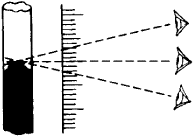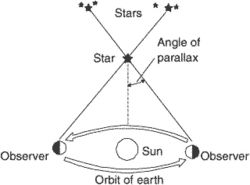parallax
parallax
(pa -ră-laks) The angular displacement in the apparent position of a celestial body when observed from two widely separated points. It is thus the angle that the baseline connecting two viewpoints would subtend at the object (see illustration). It is very small in value and is usually expressed in arc seconds. If the baseline is of a fixed length then as the distance to the celestial object decreases, its parallax will increase accordingly. If the parallax can be measured then so can the distance.The observer's position on Earth changes with the daily rotation of the Earth, the annual revolution of the Earth around the Sun, and the long-term motion of the Sun and Solar System relative to the background stars. Each motion produces a different measure of parallax: diurnal parallax, annual parallax, and secular parallax, respectively. The continual change in the apparent position of a celestial object, produced by the observer's changing position, is termed parallactic motion and must be distinguished from the star's own peculiar motion in space.
Methods used to determine the parallax and hence the distance of celestial bodies require an accurate knowledge of the baseline length. The baseline for diurnal parallax – the Earth's radius – can be used for distance measurements only within the Solar System. The baselines used in annual parallax – the semimajor axis of the Earth's orbit – and secular parallax are sufficiently great for stellar distances to be measured. Other methods based on the concept of parallax and used in distance determination include dynamical parallax, moving-cluster parallax, and statistical parallax.
Distances determined indirectly from stellar brightness are also sometimes called parallaxes: in spectroscopic parallax the absolute magnitude of a main-sequence star is deduced from the spectral type of the star using the Hertzsprung–Russell diagram and this together with the apparent magnitude gives the distance modulus and hence the distance. See also distance determination.
Parallax
(pop culture)parallax
[′par·ə‚laks]parallax


ii. The difference in the direction of a celestial object as seen by an observer from two widely separated points. The measurement of parallax is used directly to find the distance of the body from the earth and from the sun.
iii. The phenomenon in radar imagery when a tall object is imaged and the top of the object is nearer the aircraft. In this case, the slant range to the top of the object is less than that to the base. The object appears to lie toward the aircraft flight path. This is known as radar parallax.
Parallax
the apparent change in the relative position of an object as a result of movement of the observer’s eye. Parallax can cause errors in the reading of a scale that is not in direct contact with an object whose length is being measured or whose position

is being determined (see Figure 1). In optical instruments, such as telescopes or microscopes, parallax results from the observer’s eye movement in front of the eyepiece when the graticule or cross hair used for measurement is not in the same plane as the image produced by the objective. The concept of parallax plays an important role in astronomy.
Parallax
in astronomy, the apparent displacement of bodies on the celestial sphere as a result of the movement of the observer in space. The earth’s rotation about its axis is the cause of diurnal parallax, the earth’s revolution about the sun is responsible for annual parallax, and the solar system’s motion in the Galaxy causes secular parallax. Given accurate measurements of the parallactic shifts of celestial bodies or groups of bodies, the bodies’ distances can be determined.
Diurnal parallax. The diurnal parallax of a celestial body is the angle whose vertex is at the center of the body and whose sides are directed toward the earth’s center and the observer’s location on the earth’s surface. The magnitude of the diurnal parallax depends on the zenith distance of the celestial body and varies with a period of 24 hours. The parallax of a body located on the horizon of the observer is called the horizontal parallax; if the observer is on the equator, the horizontal parallax is referred to as the equatorial horizontal parallax and is constant for bodies located at a constant distance from the earth. The relation between the equatorial horizontal parallax p0 of a celestial body and the body’s geocentric distance r is given by the formula
![]()
where R is the radius of the earth’s equator. The distance to the sun, moon, or other bodies within the solar system can be expressed in terms of the body’s equatorial horizontal parallax. Thus, the value 8.79” is taken for the mean distance to the sun, and 57’ 2.6” is taken for the mean distance to the moon. Because the stars are very distant from the earth, diurnal parallax has practically no effect on their positions.
Annual parallax. The annual parallax of a celestial body is the small angle in the right triangle whose hypotenuse is the distance from the sun to the star and whose small leg is the semimajor axis of the earth’s orbit. Annual parallax can be used to determine the distances to stars. Because they are very small, these parallaxes can be regarded as inversely proportional to the distances to the stars; a parallax of 1 “corresponds to a distance of one parsec. The parallax of the nearest star, Proxima Centauri, is 0.76”. Parallaxes determined from the direct measurement of the apparent displacements of stars against a background of considerably more distant stars are called trigonometric. Because of their small value, trigonometric parallaxes have been successfully measured for only the nearest stars. The comparison, however, of the stars’ absolute magnitudes, which can be computed from the stars’ parallaxes, with certain properties of the stars’ spectra has permitted the discovery of relationships that can be used to estimate the distances to other, more remote stars, for which trigonometric parallaxes cannot be determined. Parallaxes computed in this way are called spectroscopic parallaxes.
Secular parallax. The secular parallax of a star is the star’s angular displacement in a year as a result of the motion of the solar system; the displacement is relative to a direction perpendicular to this motion. In contrast to diurnal and annual parallaxes, which are connected with periodic shifts of stars on the celestial sphere, secular parallax is determined by a parallactic shift that increases continuously over time. Because of the proper motions of the stars, secular parallaxes can be determined only statistically, that is, with respect to a sufficiently large group of stars; the peculiar motions of the stars in the group are assumed to average zero. Secular parallaxes are made use of in stellar astronomy, since they permit the estimation of distances that are considerably larger than the distances that can be obtained by measurements of annual parallaxes. The distances corresponding to secular parallaxes, however, are only averages that hold for the entire group of stars involved in the measurements; the distances may differ considerably from the actual distances for individual stars.
REFERENCE
Parenago, P. P. Kurs zvezdnoi astronomii [3rd ed.]. Moscow, 1954.N. P. ERPYLEV

